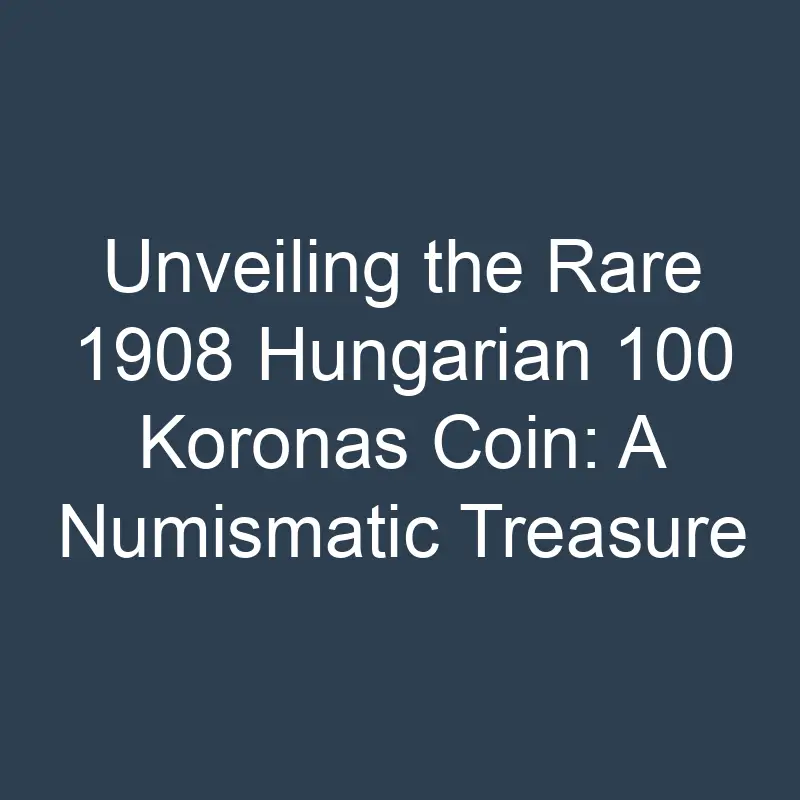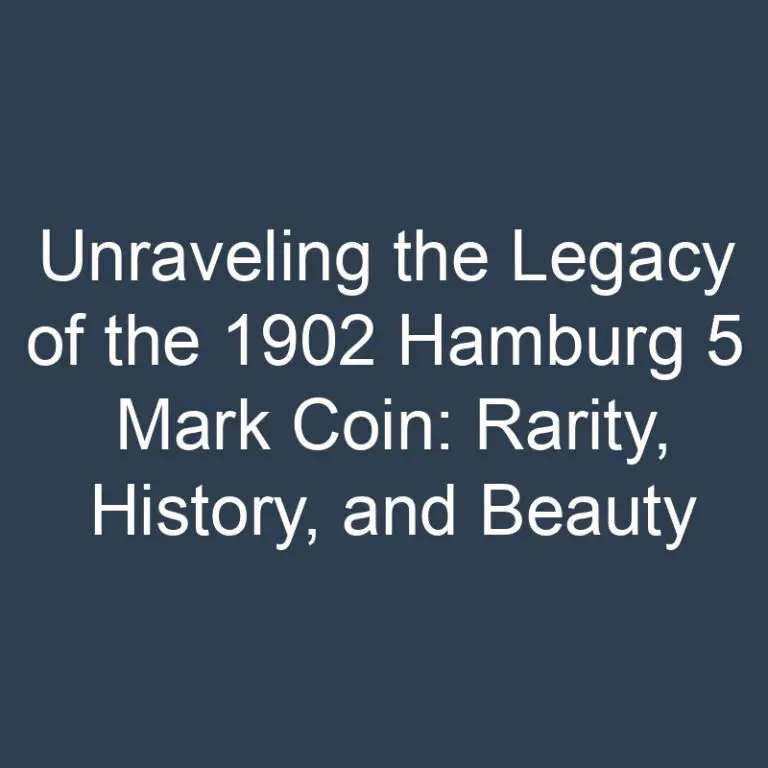
Are you curious about the 1908 Hungarian 100 Koronas? We’re diving into the history and significance of this fascinating coin. Minted over a century ago, this coin holds a unique place in numismatic history. Join us as we explore its design, composition, and the stories it carries.
With its intricate details and historical context, the 1908 Hungarian 100 Koronas is a collector’s delight. From its connection to the Austro-Hungarian Empire to its value in today’s market, there’s much to uncover about this numismatic gem. Let’s embark on a journey to unravel the mysteries and allure of this iconic coin.
Design of the 1908 Hungarian 100 Koronas
When examining the design of the 1908 Hungarian 100 Koronas, we are struck by the coin’s intricate detailing and historical significance. The obverse side features the bust of Emperor Franz Joseph I, ruler of the Austro-Hungarian Empire, while the reverse showcases the Hungarian coat of arms adorned with the Hungarian crown.
The impeccable craftsmanship of the coin is evident in the fine detailing of Franz Joseph I’s uniform and the regal aura surrounding the Hungarian crown. This fusion of symbolism representing both the Austrian and Hungarian elements is a testament to the dual monarchy of the era.
One cannot help but marvel at the artistry of the 1908 Hungarian 100 Koronas, a masterpiece minted over a century ago. The intricate engravings, the dignified portrait of Emperor Franz Joseph I, and the symbolic imagery all contribute to the numismatic allure of this historical treasure.
In the world of numismatics, the design of a coin can often hold as much value and significance as its metal composition. The 1908 Hungarian 100 Koronas stands as a prime example of a coin that seamlessly blends artistic beauty with rich historical context, making it a prized possession for collectors and history enthusiasts alike.
Composition of the Coin
The 1908 Hungarian 100 Koronas is a numismatic masterpiece crafted from a blend of 90% gold and 10% copper, giving it a distinctive luster and durability. This composition was carefully chosen to ensure the coin’s longevity and resistance to wear, maintaining its beauty over time.
With a total weight of 0.9802 troy ounces, the coin has a diameter of 23 mm and a thickness of 1.47 mm. Its reeding along the edge serves both practical and aesthetic purposes, aiding in the prevention of counterfeiting while adding a touch of sophistication to its design.
The obverse side of the coin features a striking rendition of Emperor Franz Joseph I, showcasing the fine details of his uniform and the regal presence he embodies. On the reverse side, the Hungarian coat of arms takes center stage, adorned with the Hungarian crown, symbolizing the nation’s sovereignty and historical significance.
Crafted with precision and artistry, the 1908 Hungarian 100 Koronas stands as a testament to the skilled craftsmanship of its time, alluring both collectors and history enthusiasts with its blend of historical symbolism and aesthetic beauty.
Historical Significance
- Issued during the reign of Emperor Franz Joseph I, the 1908 Hungarian 100 Koronas coin holds significant historical value.
- This coin represents the last year of the pre-World War I coinage era under the Austro-Hungarian Empire.
- Emperor Franz Joseph I, who ruled for over 68 years, was an iconic figure known for his extensive reign and the significant changes that occurred during his time.
- The Hungarian coat of arms with the Hungarian crown depicted on the coin symbolizes the country’s sovereignty and historical legacy.
- The blend of 90% gold and 10% copper not only contributes to its luster and durability but also reflects the economic and political landscape of the time.
- Collectors and history enthusiasts value this coin not only for its craftsmanship but also for the window it provides into the bygone era of the Austro-Hungarian Empire.
| Emperor | Reign Length | Composition |
|---|---|---|
| Franz Joseph I | Over 68 years | 90% gold, 10% copper |
Connection to the Austro-Hungarian Empire
When exploring the 1908 Hungarian 100 Koronas coin, it’s crucial to recognize its deep-rooted Connection to the Austro-Hungarian Empire. This coin not only served as a significant element of the empire’s monetary system but also reflected the political and economic unity between Austria and Hungary during that period.
Emperor Franz Joseph I’s reign was marked by a close alliance between these two nations, encapsulated by the dual monarchy structure. The coinage of the 100 Koronas, with its intricate design and composition, symbolizes the strength and stability of this union.
The Hungarian coat of arms on the reverse side of the coin represents Hungary’s autonomy within the empire, highlighting its rich cultural heritage and historical significance. This imagery, coupled with the depiction of Emperor Franz Joseph I on the obverse side, captures the essence of the empire’s multinational character.
As a numismatic artifact, the 1908 Hungarian 100 Koronas coin serves as a tangible link to a bygone era of European history. Its presence in collections and among enthusiasts not only preserves the legacy of the Austro-Hungarian Empire but also allows us to appreciate the intricate web of connections that shaped the past.
Value in Today’s Market
When it comes to collectible coins, the 1908 Hungarian 100 Koronas holds a special place in the hearts of numismatists and history enthusiasts. Its historical significance, combined with its intriguing design and precious metal composition, make it a sought-after piece for collectors worldwide.
In today’s market, the value of the 1908 Hungarian 100 Koronas coin can vary based on several factors. These include the coin’s condition, rarity, demand, and current gold prices. Coins in excellent condition with minimal wear and full luster tend to fetch higher prices due to their aesthetic appeal and collector desirability.
Additionally, the historical context of the coin plays a significant role in determining its value. As a relic from the pre-World War I era and a representation of the Austro-Hungarian Empire, the 1908 Hungarian 100 Koronas carries historical weight that adds to its collectible worth.
For those looking to add a piece of numismatic history to their collection, the 1908 Hungarian 100 Koronas offers a blend of artistry and legacy that transcends time. Whether you are a seasoned collector or a novice enthusiast, this coin encapsulates a bygone era of European history and serves as a tangible link to Emperor Franz Joseph I’s reign and the multinational character of the Austro-Hungarian Empire.
Key Takeaways
- The 1908 Hungarian 100 Koronas is a numismatic gem with intricate design and historical significance.
- It is crafted from 90% gold and 10% copper, showcasing durability and a distinctive luster.
- This coin represents the last year of the pre-World War I coinage era under Emperor Franz Joseph I.
- It symbolizes the union between Austria and Hungary in the Austro-Hungarian Empire through its design and composition.
- The value of the 1908 Hungarian 100 Koronas varies based on factors like condition, rarity, demand, and historical context.
- Collectors and history enthusiasts cherish this coin for its blend of artistry, history, and connection to the past.
Conclusion
The 1908 Hungarian 100 Koronas coin is a captivating piece that intertwines history, artistry, and value in the realm of numismatics. Its portrayal of Emperor Franz Joseph I and ties to the Austro-Hungarian Empire make it a sought-after collectible with a story to tell. Factors like condition, rarity, and market demand play a role in determining its worth, with well-preserved specimens fetching higher prices. As a relic from a pivotal era in European history, this coin bridges the past with the present, offering collectors a tangible connection to a bygone time. Its blend of historical significance and aesthetic appeal cements its status as a cherished item in the world of coin enthusiasts.
Frequently Asked Questions
What is the significance of the 1908 Hungarian 100 Koronas coin?
The coin is noted for its historical importance and portrayal of Emperor Franz Joseph I, appealing to numismatics and history enthusiasts worldwide.
What factors affect the value of the 1908 Hungarian 100 Koronas coin?
Condition, rarity, demand, and gold prices play a key role in determining the value. Well-preserved coins generally command higher prices in the market.
Why is the historical context of the coin important?
As a relic from the pre-World War I era and a symbol of the Austro-Hungarian Empire, the coin’s historical background adds to its collectible value.
What makes the 1908 Hungarian 100 Koronas coin a prized possession?
The coin offers a unique blend of artistry and legacy, serving as a tangible link to a significant era in European history, making it highly sought after by collectors.






